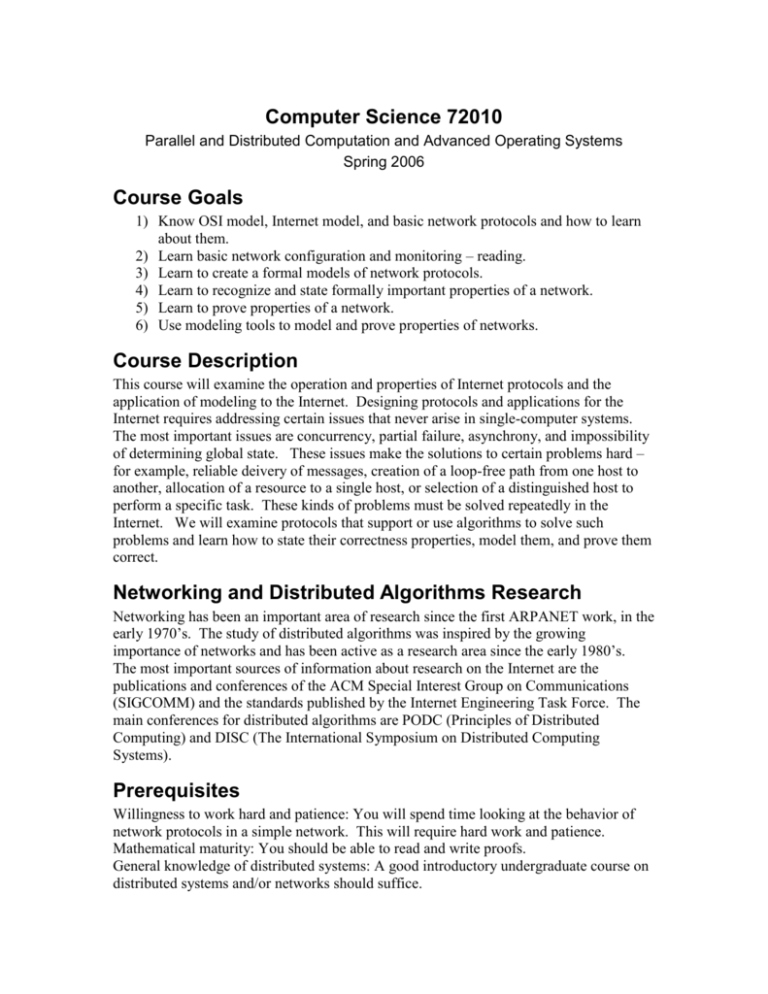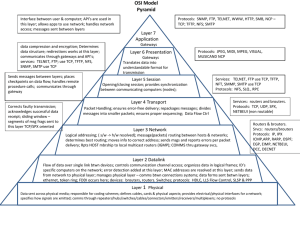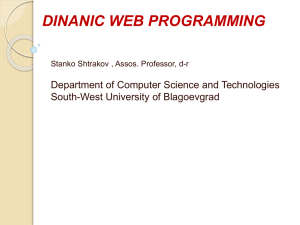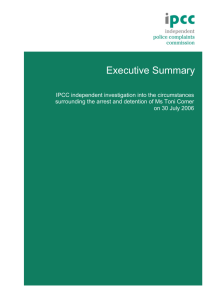Syllabus - Lehman College - Department of Mathematics and
advertisement

Computer Science 72010 Parallel and Distributed Computation and Advanced Operating Systems Spring 2006 Course Goals 1) Know OSI model, Internet model, and basic network protocols and how to learn about them. 2) Learn basic network configuration and monitoring – reading. 3) Learn to create a formal models of network protocols. 4) Learn to recognize and state formally important properties of a network. 5) Learn to prove properties of a network. 6) Use modeling tools to model and prove properties of networks. Course Description This course will examine the operation and properties of Internet protocols and the application of modeling to the Internet. Designing protocols and applications for the Internet requires addressing certain issues that never arise in single-computer systems. The most important issues are concurrency, partial failure, asynchrony, and impossibility of determining global state. These issues make the solutions to certain problems hard – for example, reliable deivery of messages, creation of a loop-free path from one host to another, allocation of a resource to a single host, or selection of a distinguished host to perform a specific task. These kinds of problems must be solved repeatedly in the Internet. We will examine protocols that support or use algorithms to solve such problems and learn how to state their correctness properties, model them, and prove them correct. Networking and Distributed Algorithms Research Networking has been an important area of research since the first ARPANET work, in the early 1970’s. The study of distributed algorithms was inspired by the growing importance of networks and has been active as a research area since the early 1980’s. The most important sources of information about research on the Internet are the publications and conferences of the ACM Special Interest Group on Communications (SIGCOMM) and the standards published by the Internet Engineering Task Force. The main conferences for distributed algorithms are PODC (Principles of Distributed Computing) and DISC (The International Symposium on Distributed Computing Systems). Prerequisites Willingness to work hard and patience: You will spend time looking at the behavior of network protocols in a simple network. This will require hard work and patience. Mathematical maturity: You should be able to read and write proofs. General knowledge of distributed systems: A good introductory undergraduate course on distributed systems and/or networks should suffice. Experience with sequential algorithms and their analysis: An undergraduate course in analysis of algorithms. Familiarity with finite state machines (automata). People Instructor Professor Nancy Griffeth Office Hours: Thursday 2-4 pm Room: 4439 (but I may be in the lab) Email: ndgriffeth@comcast.net Telephone: Lehman College Graduate Center Computer Science Department (GC) 718 960-8787 212 817-8210 212 817-8190 Grader Joel Kammet Email: jkammet@yahoo.com Reading Textbook: Douglas E. Comer, Interworking with TCP/IP: Principles, Protocols, and Architectures, Volume 1, Prentice-Hall. This is a 3-volume comprehensive work on Internet protocols, network layer and up. Get the fifth edition if you can; but the fourth will work if you are willing to deal with changed chapter numbers. Related Reading: Nancy Lynch, Distributed Algorithms, Morgan Kaufman Publishers, 1996. This is the textbook on the modeling technique we will use. Errata are available on the Web for printings prior to the fifth. Larry Peterson and Bruce Davie, Computer Networks: A Systems Approach, 3rd Edition (The Morgan Kaufmann Series in Networking). The second edition should be useful also. Behrouz A. Forouzan, Data Communications and Networking, 2nd Edition, McGrawHill. This is strong on the link layer. Manuals: The following software will be available on the lab computers. It is also downloadable to your home computer. IOA: http://theory.lcs.mit.edu/tds/ioa/ : You want the IOA Reference Guide and The Simulator Manual. Ethereal: http://www.ethereal.com/docs/ Tcpdump: http://www.tcpdump.org/ Cisco (product documentation): http://www.cisco.com/en/US/products/hw/tsd_products_support_home.html Cisco (technology documentation): http://www.cisco.com/en/US/tech/index.html Standards (or proposed standards): IEEE 802.1d, Spanning Tree Protocol IETF Standards RFC2453, STD0056, RIP Version 2. RFC2328, STP0054, OSPF Version 2. RFC793, STD0005 Transmission Control Protocol. Proposed Standards RFC4271, A Border Gateway Protocol 4 (BGP-4). RFC2018, TCP Selective Acknowledgment Options. RFC2581, TCP Congestion Control. RFC2883, An Extension to the Selective Acknowledgment (SACK) Option for TCP. RFC2988, Computing TCP’s Retransmission Timer. RFC3042, Enhancing TCP’s Loss Recovery Using Limited Transmit. RFC3390, Increasing TCP’s Initial Window. RFC3448, TCP Friendly Rate Control (TFRC): Protocol Specification. RFC3517, A Conservative Selective Acknowledgment (SACK)-based Loss Recovery Algorithm for TCP. Grading Grades will be based on homework problems, a project, a midterm, and a final. There will be an assignment and/or lab work due approximately every two weeks. The project will require you to select a one of the TCP RFC’s, select one or more interesting requirements from the RFC, model the parts of the protocol relevant to meeting the requirement, and discuss whether and when the protocol meets the requirement. (In general, standard protocols do not meet requirements in all environments; you will need to discover, in the document or through your own study, what environments the protocol needs to work correctly.) You will submit a proposed protocol and requirement for approval by April 7. The project will be due on May 19. The grades will be computed as follows: Assignments 15% Midterm 25% Project 25% Final 35% Course Outline Weeks 1 (1/26) Topic Course overview. Networks and distributed systems Modeling networks with IOA 2 (2/2) Modeling networks with IOA Introduction to Ethernet 3 (2/9) ARQ Stop-and-wait protocols 4 (2/16) Learning bridges and forwarding algorithms 5 (2/23) The spanning tree protocol 6 (3/2) IP IP Routing: RIP 7 (3/9) IP Routing: AODV, OSPF 8 (3/16) 9 (3/23) 10 (3/30) 11 (4/6) MIDTERM IP Routing: BGP TCP: Sessions (Lecturer: Constantinos Djouvas) TCP: Selective acknowledgment 12 (4/27) TCP: Congestion control 13 (5/4) DHCP 14 (5/11) 15 (5/18) Impossibility results, review Reading day: Project due! Important Dates March 16: Midterm April 6: Project Plan due May 18: Project due May 25: Probable date of final Reading Syllabus Comer Chapters 1-3, 10 Notes on distributed computing Design philosophy of the Internet IOA reference manual Comer, chapter 2 Farouzon, sections 12.2-12.3 Comer, Sections 13.4-13.5 Peterson & Davie, Section 2.5 Farouzon, Chapter 10 Comer, Sections 2.4.10, 2.5 Peterson & Davie, Section 3.2.1 Self-similarity Comer, Section 2.5 Peterson & Davie, Section 3.2.2 Farouzon, Appendix I Comer, Chapters 6-7 Comer, Chapters 13 & 15 Peterson & Davie, Section 4.2 Comer, Chapters 13 & 15 Peterson & Davie, Section 4.2 Comer, Chapter 14 Comer, Sections 12.1-12.8, 12.24-12.28 Peterson & Davie, Sections 5.2.1-5.2.3 Comer, Sections 12.9-12.17 Peterson & Davie, Sections 5.2.4-5.2.6 Comer, Sections 12.18-12.23 Peterson & Davie, Section 6.3 Comer, Chapter 22 Peterson & Davie, Section 4.1.6 Lynch, Sections 3.2, 5.1, 18.1-18.3










